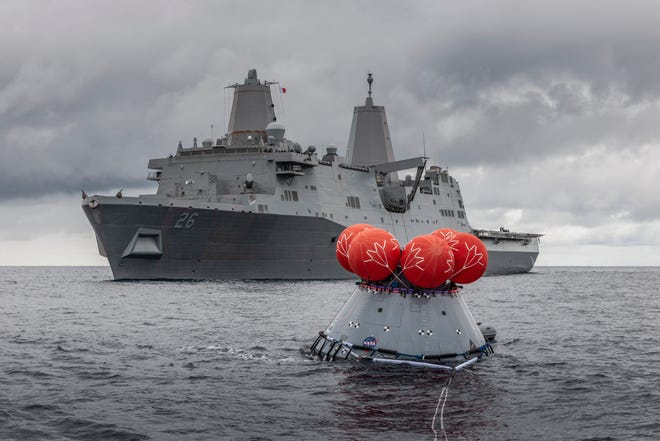
 news
news 
[ad_1]
After pedaling his bicycle to the barrier-island dunes in Melbourne Beach, Florida Institute of Technology professor J. Travis Hunsucker watched NASA’s mighty Artemis I moon rocket arc a fiery path across the post-midnight sky last month, twinkling into a tiny dot over the Atlantic Ocean.
Now, the ocean engineering and marine sciences assistant professor has reported to the Navy amphibious transport ship USS Portland in San Diego. On Sunday, he’ll help forecast and analyze wave dynamics to guide NASA officials as they retrieve the rocket’s bobbing Orion capsule after it splashes down into the Pacific Ocean.
“It’s just like, whoa. I saw this vehicle drop off the horizon on our beach. We see these beautiful photos of it orbiting the moon. And then, you’ll see it come into the well deck four weeks later,” Hunsucker said, referring to the lower level of the ship that will be flooded to load the capsule onboard.
“I’m going to be on the other coast of the United States seeing the same engineering article, picking it up in the ocean,” he said.
More:Artemis I: NASA’s Orion breaks records at the halfway mark of its deep-space journey
More:NASA: Artemis rocket’s ‘eye-watering’ power damaged mobile launcher at KSC

The 322-foot Artemis I rocket bolted skyward Nov. 16 from pad 39B at Kennedy Space Center, lifting an uncrewed Orion capsule on an epic 1.3-million-mile trek looping twice around the moon.
Concluding its 25½-day mission, Artemis’ Orion capsule will slow from a dizzying 25,000 mph – roughly a dozen times faster than a rifle bullet – to 300 mph after entering the Earth’s atmosphere. The capsule’s heat shield should reach a roasting 5,000 degrees, or twice the temperature of molten lava.
After a series of parachutes deploy, NASA engineers predict the 11-by-16½-foot capsule should slow to about 20 mph before gliding earthward and striking the sea’s surface within eyesight of the recovery ship’s crew, 50 to 60 nautical miles off the San Diego coast.
Upon splashdown, Melissa Jones, NASA’s Artemis I landing and recovery director, said “we’re frantically trying to get to the capsule” to recover pieces of jettisoned hardware that could sink into the ocean’s depths. This includes the spacecraft’s ring-shaped forward bay cover, which protects the parachutes and other soft goods during reentry.
“NASA’s all about data. And we also want to fly crew on the next mission. So this is a key test flight for us, in order for us to get that data back,” Jones said.

Comprised of about 95 people, the Orion landing and recovery team includes Navy amphibious specialists piloting inflatable boats; NASA engineers and technicians from KSC and Johnson Space Center in Houston, Texas; Air Force weather specialists; and Lockheed Martin Space Operations personnel. A helicopter squadron from nearby Naval Air Station North Island will provide aerial spotting.
The Portland will approach the bobbing Orion, and divers will use sensors to conduct “sniff checks” for leaking hydrazine or ammonia from the capsule, Jones said. Then Navy personnel will attach tending lines to Orion and flood the ship’s well deck with about 6 feet of seawater, and a cable will tow the floating spacecraft through the ship’s lowered stern gate into a specially designed cradle.
Afterward, the Portland will transport the capsule to a pier at Naval Base San Diego.
Jones said the primary splashdown site is located within a Navy fleet training area – a move designed to keep recreational boats at bay. In August 2020, a makeshift flotilla of private vessels swarmed the SpaceX Crew Dragon Endeavour after it splash-landed in the Gulf of Mexico near Pensacola with astronauts Bob Behnken and Doug Hurley aboard.

The Orion crew module is designed to carry four astronauts to deep space during future missions within a 330-cubic-foot habitable area. Jones said Sunday’s recovery team will also hustle to try to recover the capsule’s three main parachutes for scientific analysis.
Jones said the recovery team will have about six hours to collect samples and imagery and conduct assessments and tests before towing the uncrewed capsule into the well deck. This will include about 1½ hours of imagery documenting the condition of the heat shield before it touches anything inside the Portland.
Three mannequins equipped with sensors are aboard Orion for test purposes. By contrast, Artemis II will propel four astronauts on a lunar flyby.
Liliana Villarreal, who will direct NASA’s capsule-recovery campaign for that mission, said Artemis II astronauts will maneuver out of Orion’s hatch in open water before the crew module is winched into a Navy ship – and the astronauts must report to the ship’s medical bay within two hours.
“It’s completely different. There’s a lot of equipment that we have to ensure is turned off before we can do that,” Villarreal said. “There are interfaces with the crew’s suits that we’ve got to make sure that we disconnect for the crew to exit the vehicle safely.”

Jones was born and raised in Oak Hill, a small Volusia County city of about 2,000 residents off U.S. 1 just north of KSC and the Merritt Island National Wildlife Refuge.
Because of her deep family ties with the Cape, she suspects her NASA career was “in my blood.” As a kid, she thought space travel was commonplace: “I kind of grew up thinking that walking out into the front yard and looking at a launch was normal, I guess.”
“My grandfather was a security guard at KSC, and my grandmother worked in the gift shop. My dad was a manager on the Titan program. My mom was a NASA quality inspector,” Jones said.
While attending the University of Central Florida, Jones recalled getting a February 2003 phone call from her mother, Sue Hutchinson, who was standing at the 15,000-foot-long Shuttle Landing Facility waiting for shuttle Columbia to return to the Cape.
“She called and woke me up, and she said, ‘Get up and turn the news on.’ And she hung up. And she was out there the rest of the day,“ Jones recalled.
Columbia had tragically broken apart over Texas during atmospheric reentry, killing all seven astronauts aboard.

In January 2004, Jones joined NASA’s shuttle program as a contractor on its return-to-flight mission, which culminated with Discovery’s successful launch in July 2005. By 2007, she was NASA’s lead orbiter project engineer for shuttle Endeavour.
Jones is NASA’s first capsule recovery director based at KSC: Her Apollo-era counterparts were based in Texas at Johnson Space Center in Houston.
“I’m really the first person that’s ever done this job before – and we’ve not done it for over 50 years. It’s an honor to have been chosen to do this,” Jones said.
“That foundation of space was set for me by my family, and I am continuing that legacy. And I hope that my kids see that, and they want to continue it too,” she said.

Hunsucker has spent the days leading up to Sunday’s splashdown working on wave forecasts along the San Diego coast, where Pacific swells can originate across a broad geographic swath ranging from the Gulf of Alaska down into the southern hemisphere.
He has spent the past four years analyzing Orion-recovery wave-forecast data with the Johnson Space Center meteorology group, particularly from NASA’s recovery exercises using mock capsules. A critical component of his job: Position the Portland to minimize waves inside the ship’s well deck.
“You have this 700-foot-long ship that’s impacted by the waves. It starts moving around. Inside of that ship, you have a well deck. It, too, has waves that are generated from the moving of the ship,” Hunsucker said.
“My role is to understand how the ocean waves affect the ship’s motion, how the ship’s motion affects the well-deck waves, and in turn how the well-deck waves affect the crew module,” he said.

NASA’s Orion recovery team completed a three-day “final rehearsal” exercise at sea last week aboard the Portland using a mockup capsule. Jones said Johnson Space Center personnel will select Sunday’s splashdown location based on weather conditions and flight rules outlining “sea state” requirements for wave action and “winds aloft” standards to ensure that the parachutes function properly.
If conditions warrant, Orion could alternately splash down just southeast of the Catalina Islands near Los Angeles, NASA Flight Director Judd Frieling said during a Monday briefing. Or, Orion could land “short” – about 1,200 nautical miles south of San Diego. He described this trio of splashdown sites as a Plan A/Plan B/Plan C slate of options.
The large red balloons attached to the capsule are prominent features of the crew module uprighting system amid rolling ocean waves, said Carla Rekucki, lead test director with NASA’s Exploration Ground Systems program.
Hunsucker, who is working via contract with Jacobs Technology, said the Portland’s heading will also depend on the shapes and steepness of incoming waves. He likened the exercise to driving a vehicle through a parking lot riddled with potholes.
“I think we all hope that we land on a beautifully calm, flat, quiescent day,” Hunsucker said.
NASA’s Orion capsule is expected to splashdown at 12:40 p.m. EST Sunday, Dec. 11. Watch live coverage at floridatoday.com beginning at 11 a.m.
Rick Neale is the South Brevard Watchdog Reporter at FLORIDA TODAY (for more of his stories, click here.) Contact Neale at 321-242-3638 or rneale@floridatoday.com. Twitter: @RickNeale1